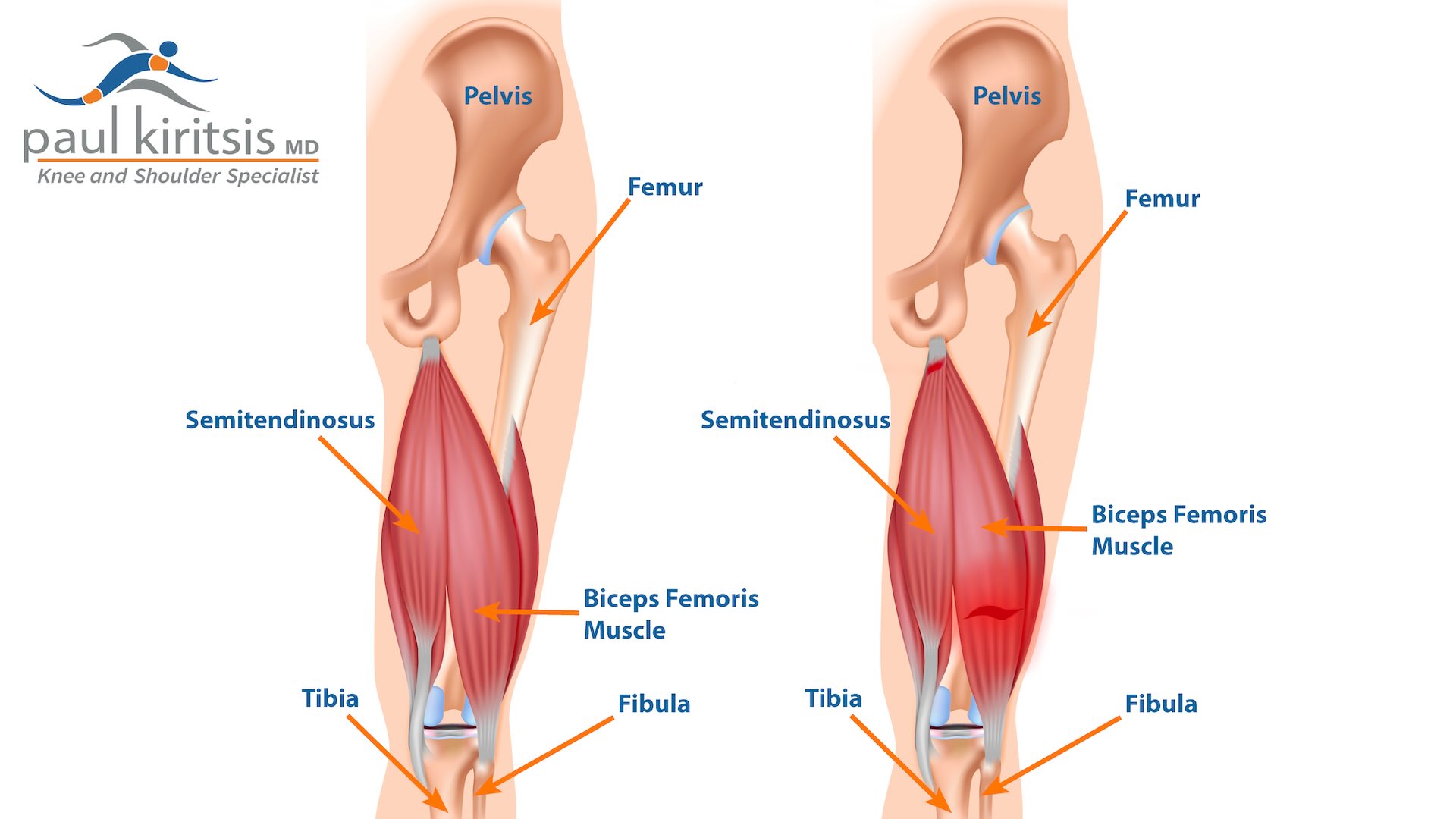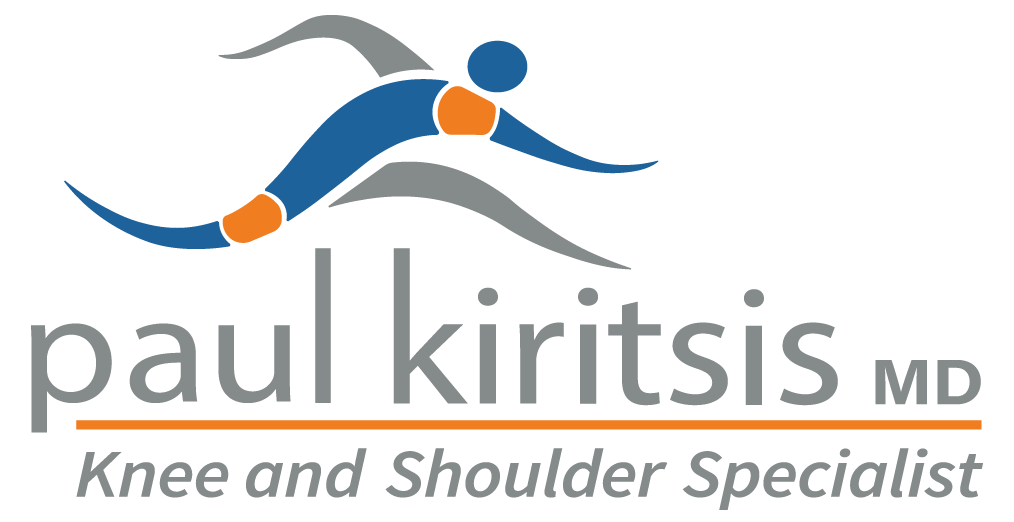Can a hamstring injury cause knee pain? Yes, it most certainly can. Hamstring injuries can create muscle imbalances and tightness, leading to increased knee stress. Read on to learn more about the symptoms, causes, and treatments for knee pain resulting from hamstring injuries.
Key Takeaways
- Hamstring injuries can cause knee pain by disrupting stabilization and increasing stress on the knee joint, leading to conditions like patellofemoral pain syndrome.
- Recognizing symptoms such as swelling, stiffness, and weakness around the knee is important for diagnosing hamstring-related knee pain and determining appropriate treatment.
- Preventing hamstring injuries involves proactive muscle conditioning, proper warm-ups, and regular stretching, particularly for athletes prone to sudden movements.
Understanding Hamstring Injuries
Hamstring injuries, commonly known as ‘pulled hamstrings’, can range from minor strains to severe tendon tears, including a hamstring strain. These injuries occur when the hamstring muscles are overstretched or overloaded, leading to muscle fibers tearing. The hamstring muscle group, located at the back of the thigh, consists of three muscles: the biceps femoris, semitendinosus, and semimembranosus.

A severe hamstring injury, such as a complete tear, can result in tendon avulsion, a condition where the hamstring tendons detach from the bone, sometimes pulling a fragment of bone with them. Such injuries are more than just painful; they can significantly impair movement and require extensive recovery time, especially where hamstring tendons attach.
Common causes of hamstring injuries include muscle overload, often due to excessive stretching or sudden application of force. Imbalances between the hamstring and quadriceps muscles can also contribute to the risk of injury. Athletes, in particular, need to be vigilant about maintaining balanced muscle strength and flexibility to avoid these injuries.
Hamstring tendonitis is another concern, developing gradually from overuse or improper exercise form. Symptoms may include a gradual onset of hamstring pain and swelling at the back of the thigh. Differentiating between tendonitis and more severe tendon tears is important, as the latter can lead to more serious injuries and require different treatment approaches.
How Hamstring Injuries Can Lead to Knee Pain
The hamstring muscles play a pivotal role in stabilizing the knee and controlling its dynamic movement. When these muscles are injured or tight, they can disrupt this stabilization, leading to knee pain. Tight or weak hamstrings can create muscle imbalances that increase the likelihood of knee pain.
Tight hamstrings, in particular, can increase stress on the knee joint. This added stress can exacerbate conditions like patellofemoral pain syndrome or even contribute to the development of osteoarthritis in the knee. Overworking the hamstrings can lead to tightness, which further aggravates knee pain.
Proper warm-ups and stretching routines are essential to mitigate hamstring tightness and the associated knee pain. Flexible and strong hamstrings are important for optimal knee joint function and pain-free movement.
Identifying Symptoms of Hamstring-Related Knee Pain
Recognizing the symptoms of hamstring-related knee pain is the first step toward effective treatment. Common symptoms include swelling, bruising, stiffness, weakness, a popping sensation, and tenderness around the knee joint. These symptoms often arise after a sudden injury or overuse of the hamstring muscles.
Hamstring tendonitis, specifically, manifests as pain or swelling at the back of the thigh, which can radiate down to the knee. If the pes anserine bursa, a fluid-filled sac located near the knee, becomes inflamed, you might experience pain, tenderness, and swelling in the knee area.
Additionally, pain radiating from the back to the knee, accompanied by numbness or a pins-and-needles sensation, may indicate a nerve issue. These symptoms highlight the need for a thorough diagnosis to determine the exact cause of knee pain and appropriate treatment.
Diagnosing Hamstring-Related Knee Pain
An accurate diagnosis is important for treating hamstring pain behind the knee. If knee pain persists despite at-home treatments, it’s important to seek professional evaluation to identify the root cause. During a physical exam, an orthopedic surgeon will often extend and flex the leg to check for pain and assess the range of motion.
A physical therapist will also inquire about your warm-up routines, activities, and exercise preferences to gather a comprehensive history. In severe cases, imaging tests like an MRI may be necessary to confirm the diagnosis and rule out other conditions such as Baker’s cysts, meniscus tears, or ligament injuries.
Effective rehabilitation includes a tailored treatment plan that addresses specific deficits in each patient. This might involve strength training, neuromuscular control exercises, and functional movements to ensure a full recovery and prevent reinjury.
Immediate Treatment for Hamstring Injuries
When a hamstring injury occurs, immediate treatment is essential to manage pain and promote healing. The R.I.C.E. method—Rest, Ice, Compression, Elevation—effectively manages minor injuries. Resting from strenuous activities gives the muscles time to heal, while applying ice packs several times daily helps alleviate pain and reduce swelling.
Using a compression bandage can support the injured area and control swelling. This is particularly useful in the early stages of recovery. Keeping the injured leg elevated also helps to minimize swelling and promote healing.
Over-the-counter pain relievers like ibuprofen or acetaminophen can assist in managing pain. These initial steps play an important role for minimizing damage and setting the stage for a smooth recovery.
Long-Term Management and Recovery
Long-term management of hamstring injuries focuses on enhancing recovery through proper rehabilitation and awareness of muscle fatigue. Strengthening the hamstring muscles is vital for enduring more stress and reducing the risk of future injuries.
Athletes should avoid end-range stretching if it causes pain during the rehabilitation process to prevent worsening the injury. Adequate rest after exercise allows the muscles to recover and prevents fatigue-related injuries. A comprehensive treatment plan tailored to individual needs is key to achieving a full recovery and returning to everyday activities.
Preventing Hamstring Injuries and Knee Pain
Preventing hamstring injuries and the associated knee pain involves a proactive approach to muscle conditioning and flexibility. A proper warm-up, such as a 5 to 10-minute walk or dynamic stretches like high knees, enhances blood flow and prepares muscles for activity. Incorporating static stretches held for 15 to 30 seconds post-activity can significantly improve hamstring flexibility.
Regularly practicing stretching and strengthening exercises helps reduce the likelihood of developing hamstring-related knee pain. Athletes engaged in sports that involve sudden starts and stops should be cautious and maintain strength through balanced training.
Young athletes, in particular, should focus on muscle conditioning to minimize the risk of hamstring injuries. Given that previous hamstring injuries can increase the risk of future strains, proper recovery and future prevention are important.
When to Seek Professional Help
Knowing when to seek professional help is vital for managing hamstring injuries effectively. If the injury feels severe enough to require immediate care, an emergency department visit is recommended. Professional consultation is essential if symptoms worsen or healing does not occur as expected.
Sudden numbness or tingling in the leg following a hamstring injury warrants immediate medical attention. Increased swelling after a hamstring injury should also prompt a visit to a healthcare provider to ensure proper treatment and recovery.
Summary
Understanding the intricate link between hamstring injuries and knee pain is important for both prevention and effective treatment. By recognizing the symptoms, seeking timely diagnosis, and following appropriate treatment plans, individuals can manage these injuries and prevent long-term complications.
Proper warm-ups, stretching routines, and strength training are essential preventive measures. For those recovering from hamstring injuries, tailored rehabilitation programs and professional guidance can pave the way to a full recovery and a return to normal activities.
Frequently Asked Questions
Can hamstring injuries cause knee pain?
Indeed, hamstring injuries can lead to knee pain, as the hamstrings play a vital role in stabilizing the knee joint during movement. Addressing hamstring injuries is essential for preventing knee discomfort.
What are the symptoms of hamstring-related knee pain?
Hamstring-related knee pain often presents with swelling, bruising, stiffness, weakness, and tenderness, along with a popping sensation and pain that radiates from the back of the thigh to the knee. Recognizing these symptoms early can aid in effective management.
How are hamstring injuries diagnosed?
Hamstring injuries are diagnosed through a combination of physical examinations that assess pain and range of motion, patient history, and may include imaging tests such as an MRI. Proper diagnosis is essential for effective treatment and recovery.
What immediate treatments are recommended for hamstring injuries?
For immediate treatment of hamstring injuries, you will want to follow the R.I.C.E. method: Rest, Ice, Compression, and Elevation, along with using over-the-counter pain relievers for relief. This approach helps reduce swelling and pain effectively.
How can I prevent hamstring injuries and knee pain?
To prevent hamstring injuries and knee pain, focus on proper warm-ups, stretching, and strength training. Consistently incorporating these practices will significantly lower your risk of injury.





